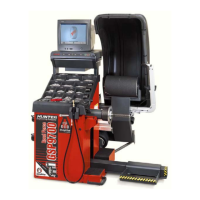138 8. Theory of Operation GSP9700 Series Road Force Measurement System Operation
Conicity
Conicity is the primary lateral tire force measurement that contributes to vehicle pull
problems. When combined with other tire and vehicle variables, the vehicle may drive
off line if the steering wheel is released. The steering wheel may be straight when the
vehicle travels straight, but the driver must exert a force to the wheel to maintain the
straight-ahead stability. This can result in driver annoyance, fatigue, and safety
related concerns. Conicity is sometimes called “tire camber” and it affects the vehicle
in a similar manner to suspension alignment angles.
Conicity forces will usually not cause a pull or drift issue when tires of similar values
are mounted on the same vehicle. It is the net difference between the two tires on the
steering axle that make the difference between a vehicle that rolls straight and one
that drifts or pulls.
Conicity in tires may be caused when the radial belts vary from exact placement in
the center of the tire carcass during construction. The sidewall to which the belts are
placed closer will be stiffer (and thus taller) than the opposite side. This produces a
cone shaped tire when loaded.
Conicity in tires will also be affected by tire wear, therefore conicity values typically
change during a tire’s life.
Plysteer
Plysteer induces a dog-tracking attitude of the vehicle. When large net plysteer
variations on an axle are encountered, the steering wheel will change position and
possibly end up crooked to maintain a straight direction of travel. The vehicle,
however, will not necessarily drift or change lanes when the steering wheel is
released. The driver at the steering wheel exerts no correction force. The GSP9700
measures, but does not display and correct for plysteer.
Net Tire Pull
Net Tire Pull is the measurement displayed by the GSP9700 to allow the operator to
determine the best tire placement about the vehicle. It is defined as the difference
between the lateral forces measured on the front steer axle. In most cases, a tire’s
pull value is of little concern when placed on the rear axle and does not affect the
straight-ahead stability of the vehicle.
The measured loaded tire diameter (displayed for each tire/wheel assembly) can also
affect the pull condition. A significant difference in these measurements may indicate
under/over inflation in a tire or a mismatched set of tires.
Another common factor that can affect steering pull or drift in relation to the tires is
the variation in air pressure of the two tires when compared side to side on a given
axle. Tire pressure measurement is prompted with a pop-up screen before every load
roller measurement.

